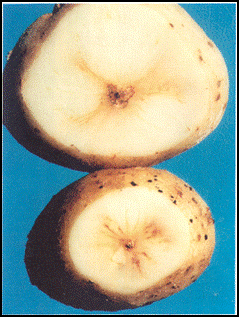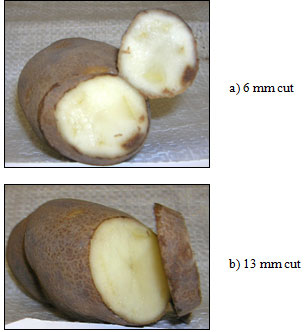PI-009: Seed Potato Tuber Inspection
Appendix 7: Stem end discolouration
This page is part of the Guidance Document Repository (GDR).
Looking for related documents?
Search for related documents in the Guidance Document Repository
Stem end discolouration may be the result of various conditions, mainly heat necrosis, frost or drought. Treatments such as chemical vine killing may produce internal discolouration, usually resulting in a light brown, narrow ring in the flesh of transversely-cut tubers. General vascular discolouration may be caused by a number of biological factors including viral (e.g. net necrosis), fungal or bacterial. The symptoms are a slight discolouration of tissue below the stem-end, discolouration of the vascular ring appearing as slight netting, or in some cases a severe brown streaking through part of, or the entire vascular ring, sometimes extending nearly to the bud end of the tuber. Severe internal discolouration beyond the stem end (beyond 6-13 mm) should be scored under Malformed and Damage.
Frost injury or frost necrosis appears as a net necrosis of tuber tissue. Fine, dark brown to grey streaks or strands occur in the vascular ring or generally throughout the tuber flesh, giving the impression of a network. If the netting is due to frost, there are usually various stages of breakdown. Most frost injury should be scored under soft rot or wet breakdown, however mild stem end discolouration due to frost may be scored under stem-end discolouration.
Scoring:
It is not necessary to identify the specific cause of stem end discolouration, but all stem end discoloration is scoreable under its own tolerance in the Seeds Regulations Part II. The shoulder must be removed to ensure the reference for measurements begin at the stem end. Penetration between 6-13 mm at the stem end is scoreable. Cuts are made at the stem end of the tuber to determine the depth of penetration. If the discolouration extends beyond 13 mm, it is scored as an Internal Discolouration under Malformed and Damaged.

Description for 34
This image of two potatoes is an example of stem discolouration. The potatoes have a light brown skin with a cream-coloured center. Both have been cut to reveal their inner section below the skin and are shown from a top view in order to demonstrate the stem discolouration. With the discolouration in this image, at the center of the cut portion of each there is a dark/golden brown spot which then lightly radiates outwards to the rest of the cut area.

Description for 35
Image a) 6 mm cut
This image of a potato is an example of stem discolouration. The potato has a russeted skin with a cream-coloured center. Six millimeters have been sliced off the stem end and left attached beside the potato to reveal its inner section below, in order to demonstrate the stem discolouration.
Image b) 13 mm cut
This image of a potato is the same potato as the picture above. Thirteen millimeters have been sliced off of the stem end of the potato and placed beside the potato to reveal its inner section in order to demonstrate that the stem end discolouration does not penetrate to thirteen millimeters.
- Date modified: